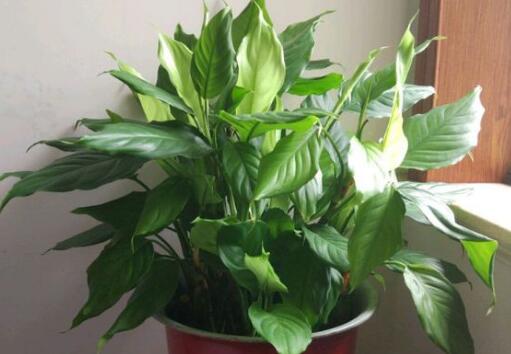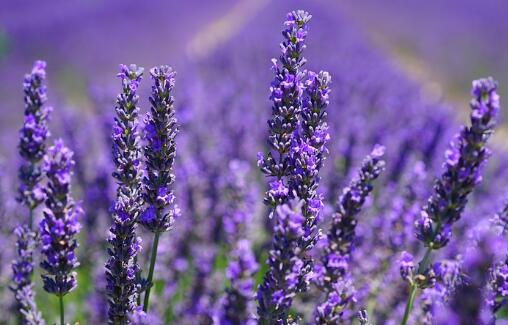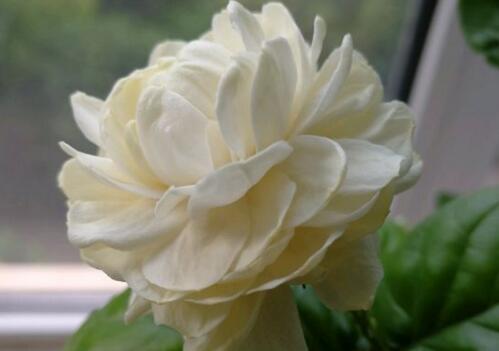How do you grow evergreen plants? Potted evergreen cultivation methods and precautions, toxic?
Evergreen nickname is iron pole, open throat sword, winter grass and so on. It is a traditional ornamental flower in China and Japan. Its leaves are green all the year round, so it is called evergreen. How to raise evergreen? What are the breeding methods and matters needing attention of potted evergreen?

Artemisia is a genus of angiosperms of the family Liliaceae, most of which are perennial herbs. the main characteristics of this genus are: roots have many fibrous roots and densely white woolly; leaves are basal and arranged in two rows of clusters; flowers are fleshy spikes and extruded in leaf axils; Corolla is often white and high-footed dish-shaped or funnel-shaped; fruit is a single-seeded berry globose. There is only one species of this genus, which is distributed in China and Japan.
Evergreen is often planted with pine and auspicious grass to express the meaning of auspicious evergreen. The Chinese people are particularly fond of the evergreen who contains the meaning of "good luck". In China's traditional decoration, there is often a pattern composed of evergreen and Ganoderma lucidum grass, which means that everything is smooth and satisfactory, that is, all goes well. Here is a detailed introduction to how to raise evergreen for you:
The species of evergreen
Evergreen is a common foliage plant, and there are six common cultivated varieties in the family: evergreen, Guangdong evergreen, tiger eye evergreen, Chinese evergreen, purple back evergreen and zebra leaf evergreen.
Breeding methods and matters needing attention of evergreen
1. Soil selection of evergreen culture
The cultivation substrate of evergreen can be composed of 2 humus soil, 2 forest rotten leaf soil, 2 sandy vegetable garden soil, 2 furnace ballast ash and 2 mature barnyard manure. The above five kinds of matrix, it is best to prepare in advance, in summer with strong sunlight exposure, and finally fine sieve can be put on the pot for standby. During cultivation, a layer of base fertilizer should be placed at the bottom of the basin, such as poultry dry manure that is fermented and ripened and mixed with a small amount of culture soil.
two。 Fertilization method of evergreen culture
The leaves of evergreen are thick and green all the year round, and they need a large amount of fertilizer. in the raw season, organic liquid fertilizers such as rotten rapeseed cakes and meat bones must be applied once every half month. After going out of the room every spring to cultivate normally, the proportion of 1: 1, 1: 6, 1: 1, and 1: 8 can be used, once every 7 / 10 days. 0.5% ammonium sulfate or calcium superphosphate was properly added to topdressing before flower bud differentiation, which was beneficial to bud flowering. Stop fertilizing before flowering, need a lot of nutrients after hanging the fruit, and apply thin fertilizer frequently to make the fruit bright and full.
3. Watering method of evergreen culture
Evergreen herbs, fleshy root flowers. It likes to be moist and afraid of stagnant water in flowerpots, so it should not be watered too much, otherwise it is easy to rot the roots. Spring watering, can be wet with basin soil, generally 2Mel 3-day watering. Summer watering, depending on its growth, can generally be watered once a day in the evening, and sprinkler irrigation is better, so that the soil is more loose and easy for root absorption. Autumn watering, can be watered every 3 days or so, must keep the soil moist, promote the growth and development of the fruit. No matter where the evergreen is kept, it is best to put a water plate under the flowerpot so that the water is constantly immersed into the soil from the small hole, so that the basin soil is often in a moist state. But watering should be controlled in winter, and the greenhouse can be watered every 10 days. The lower the room temperature, the less watering, otherwise the roots and yellow leaves will rot in winter. At this time, to keep the air moist, often rinse the leaves with warm water (25Mel 30 ℃) to keep the leaves fresh and delicate and emerald green.
4. Temperature requirements for evergreen culture
Evergreen has strong adaptability and is suitable for cultivation in the north and south. The most suitable growth temperature is 20 ℃ and 30 ℃, and it can survive the winter safely if it is more than 7 mol in winter.
5. Lighting requirements of evergreen culture
Evergreen has a strong ability to tolerate shade and likes to grow in moist, semi-shaded or scattered light. If a large area of open field cultivation, summer to build a shed for shade. General families as ornamental cultivation, can be placed under the tall Xiyang woody flowers to avoid strong direct sunlight.
6. Matters needing attention in evergreen culture
(1) evergreen is a kind of flower that likes to be warm and humid, resistant to shade and afraid of cold. Keep it outdoors in summer and need to build a shed for shade. With strong sunlight, the leaves are easy to turn green and white, and the edges of the leaves are also easy to zoom. The optimum temperature for the growth of evergreen is 20 ℃ 30 ℃. In winter, the indoor temperature should be kept between 12 ℃ and 15 ℃, and the lowest temperature should not be lower than 7 Mel. The leaves below 7 Mel should be yellowed and shedding, and the whole plant would die in severe cases.
(2) during the growing season, evergreen would rather be wet than dry, spray water frequently when the temperature is above 25 ℃, control watering after autumn, and dry properly in winter.
(3) evergreen has strong fertilizer tolerance and appropriate amount of fertilizer should be applied. 20% cake fertilizer or 1% compound fertilizer solution should be applied every 15 to 20 days during the growing season, and fertilization should be stopped in winter. It should be shaded at noon in spring, autumn and summer, and put it in a bright place when growing indoors. But keep plenty of light in winter.
7. Breeding methods of evergreen culture
Evergreen can be propagated by ramet and sowing.
(1) ramet propagation: evergreen has luxuriant growth and well-developed root system, which consumes a lot of nutrients every year. Therefore, it is necessary to turn the basin and change the soil year after year, from February to March. The germination of evergreen is strong, and the tiller buds are easy to be produced at the base, and these new tiller buds can be propagated. Ramet can be combined with turning the pot and changing soil at the same time, the clump-shaped mother plant can be taken out of the flowerpot, shake off the attached soil, cut according to its natural gap, 3 trees in each clump, smear the incision with plant ash after cutting, and then planted in Yixing purple sand basin of suitable size, evergreen has strong regeneration ability, grows fast after ramet, and can be divided again after 4 years.
(2) sowing and reproduction: the seeds of evergreen generally mature in December. Families in the Yangtze River basin and its northern areas do not have heating equipment and cannot be sown with picking. The seeds can be stored and sown in March-April of the following year when the average temperature is about 22 ℃. According to the number of seeds, the nursery bed can be replaced by earthen pottery flowerpots, and the matrix is fully mixed with forest rotten leaf soil and fine river sand, and disinfected with high temperature. When sowing, scrape and compact the substrate, then sow the seeds evenly in the seedbed, soak the pot and pour the water thoroughly. The edge of the basin is covered with glass, and then the seedbed is placed in a warm and ventilated place. The management work after sowing is mainly to keep the substrate moist, and the seeds begin to germinate after about 15May. at this time, the glass should be removed, the balcony of the room should be strengthened and the green environment should be exposed to weak sunlight. When the seedlings grow to 5cm, they can be cultivated in different pots according to 4 plants per pot. In autumn, the cultivation soil and base fertilizer are planted in Yixing purple sand basin, and the new evergreen should be carefully maintained. Generally, after more than two years of cultivation and management, they can blossom and sit fruit and be placed indoors to watch.
8. Prevention and control of diseases and insect pests of evergreen
Ten thousand young people are often prone to leaf spot disease, anthracnose, brown soft scale and other diseases and insect pests. If you encounter diseases, you should always be ventilated and transparent, do not have stagnant water, cut off the diseased and residual branches and leaves in time, and spray appropriate amount of medicine for sterilization and disinfection, which can ensure the normal growth of the plant; if you encounter insect pests, you should spray the corresponding agents to kill them in time. If the insect pests are less, the impact is small, then scrape off the insect body on the plant with bamboo slices.
Causes and treatment of yellowing of evergreen leaves
1. Normal aging
If properly maintained, evergreen leaves yellowing is a normal metabolism, with the growth of the plant, the lower leaves begin to age and yellowing.
Treatment: there is no need to worry about the yellow leaves of evergreen, but the yellow leaves, residual leaves and some old leaves of the lower part of the plant should be pruned in time.
2. Overwatering
Evergreen is the fleshy root system, most afraid of stagnant water, therefore, can not be watered, otherwise it is easy to cause rotten roots, resulting in evergreen leaves yellowing.
Treatment: usually pour the right amount of water, to achieve the basin soil is not dry, would rather be dry than too wet. In addition to keeping the basin soil moist in summer, watering in spring and autumn should not be too frequent. But must keep the air moist, such as dry air is also prone to evergreen leaves yellowing and other adverse phenomena.
3. The sun is too strong
Evergreen happy semi-shady environment, avoid summer strong light, strong light is easy to cause evergreen leaves scorched edge or even withered yellow, the light is too strong easy to be burned by the sun, the light is too weak not easy to blossom and bear fruit, affecting the ornamental effect.
Treatment: evergreen should be shaded more than 60% in spring, summer and autumn, and 40% in winter.
4. The temperature is too low
The suitable growth temperature is 15-18 ℃, and the lowest temperature should not be lower than 5 ℃, otherwise it is easy to freeze and cause leaves to yellowing.
Treatment: evergreen winter dormancy should be moved to the greenhouse, put in the sunny place, the temperature is kept above 10 ℃, the following year can re-germinate new leaves.
5. Improper fertilization
Excessive fertilization is another common cause of yellowing of evergreen leaves, mainly caused by fertilizer damage, damage to the root system of evergreen and so on.
Treatment: evergreen growth season every 10-15 days to apply liquid fertilizer, winter should stop fertilization.
6. The leaves are too dirty
Evergreen usually should pay attention to keep the leaves clean and tidy, if the accumulation of too much dust on the leaves affects photosynthesis, it will also cause evergreen leaves to turn yellow.
Treatment: every once in a while, we should pay attention to wiping the leaves with a clean wet rag to keep the leaves clean.
Is evergreen poisonous?
The juice of the root of evergreen is poisonous, and the toxicity of Euphorbia mandshurica is different from that of Dai Fen Leaf. Evergreen can not be eaten. If you eat it accidentally, it will produce symptoms such as dizziness, headache, dizziness and vomiting after about an hour. More serious cases are numbness of the limbs, pale skin, decreased blood pressure and so on. If the above symptoms occur, please see a doctor as soon as possible.
Although evergreen is a little toxic, there is no problem as long as you do not come into contact with its juice, and it is also a valuable plant, if you put evergreen at home, it can absorb formaldehyde, nicotine and other harmful gases at home and give you a healthy living room. Put evergreen in the living room, can also decorate your living room, refreshing, the oxygen released is good for your family's health!
Time: 2019-04-10 Click:
- Prev

How to grow lavender after vanilla? When will it blossom? In which month does Yili lavender bloom?
Lavender is also known as perfume plant, spirit vanilla, vanilla, yellow vanilla, Lavender. Lavender is also known as vanilla. Very romantic lavender not only has high ornamental function, but also has high medicinal value. As a result, more and more Chinese people grow lavender. So how do you grow lavender?
- Next

In which month does tiger head jasmine usually blossom? Is it poisonous? Can you breed it indoors? What is there to pay attention to?
Tiger head jasmine belongs to jasmine species. It is a variant variety, and the gene is unstable and easy to mutate. So, in which month does tiger head jasmine usually blossom? Is it poisonous? Can you breed it indoors? What is there to pay attention to? In which month does tiger head jasmine usually blossom? The flowering period of Hutou jasmine is from May to August, and it has higher requirements for soil.
Related
- Fuxing push coffee new agricultural production and marketing class: lack of small-scale processing plants
- Jujube rice field leisure farm deep ploughing Yilan for five years to create a space for organic food and play
- Nongyu Farm-A trial of organic papaya for brave women with advanced technology
- Four points for attention in the prevention and control of diseases and insect pests of edible fungi
- How to add nutrient solution to Edible Fungi
- Is there any good way to control edible fungus mites?
- Open Inoculation Technology of Edible Fungi
- Is there any clever way to use fertilizer for edible fungus in winter?
- What agents are used to kill the pathogens of edible fungi in the mushroom shed?
- Rapid drying of Edible Fungi

